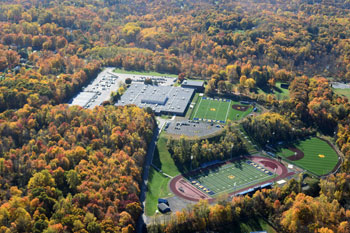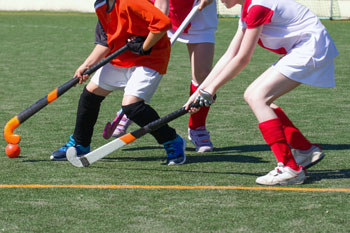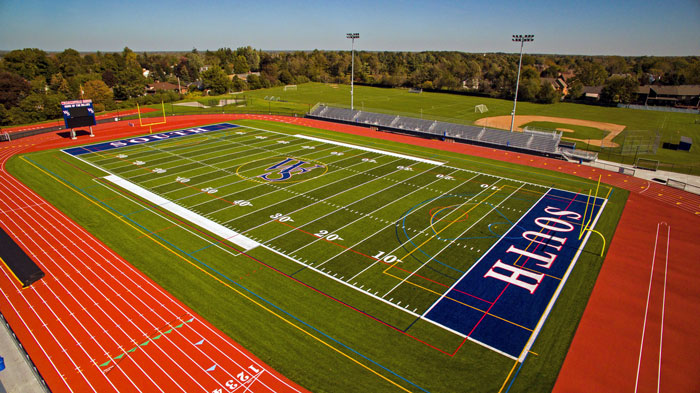With the rise of multi-use, revenue-generating philosophies in recreation, synthetic turf surfaces have become more popular, though natural grass still holds sway for many coaches, athletic directors and players.
Synthetic turf offers so much for those wanting to maximize field use and thus fees—durability and ease of maintenance being the main benefits, allowing the potential for return on a large entry investment. Artificial grass simply can take more with much less labor needed to keep it clean, hazard-free and safe.
But there are those who say natural turf has begun to trend up because of new techniques for drainage and maintenance. Potential clients are at least interested in a natural turf solution, said Jamie Mehringer, vice president of sports turf at a green industry distributor located in Wheeling, Ill. “Investigating both natural and synthetic as options and discussing the costs to build a natural grass surface with exceptional drainage to allow for all weather play” is a trend, Mehringer said. “Common feedback is ‘I didn’t know I had other options other than just a poorly draining natural grass surface and synthetic.’
“In reality, there are many different options,” he continued. “Also, soccer continues to be strong and maybe even stronger for the desire to play on natural grass across travel and college and high school levels.”
Mehringer’s company encourages the use of natural grass for sports. But today’s recreation managers often want surfaces that can be used by as many teams, clubs, classes and individuals as possible as often as possible. Dawn to dusk use, and if there are lights, play after dark.
Mehringer said the choice isn’t as simple as it seems. Natural grass is cooler than synthetic and improves air quality, he said. “With proper planning and design, natural grass can take a large amount of play,” he said. ”Part of this planning would be proper grade, rootzone, drainage, irrigation and grass selection. The field needs to be designed to add water when needed and rapidly remove water during and after rain events.”
Though he’s a natural turf advocate, Mehringer admits that synthetic has its advantages. “If the field is completely landlocked and play is requested in excess of three to eight hours per day, synthetic may be a better fit,” he said. ”All-weather play is the main reason you are seeing synthetic becoming more prevalent in travel baseball,” for example.

The negative aspects of synthetic turf are cost, heat, disposal and possible injury issues. Synthetic turf folks have answers for all those, but Mehringer foresees a future when natural grass will hold a stronger position than most assume.
“I think both natural and synthetic will be in play as we move forward,” he said. “I do think that natural grass fields are poised to make a greater return to flip fields back to natural grass. History shows this can be cyclical. For this to happen, fields will continue to need to be designed, built and maintained at a high level with the focus on safe and playable surfaces.”
Safety is the main angle synthetic field folks have to work when promoting their product. The use of a type of synthetic turf named “slit-film” in the NFL and on fields played on by NFL teams in England and Germany stoked controversy this past fall for higher risk of lower extremity injury.
While the slit-film issue is fresh, synthetic fields companies have plenty of experience quelling fears. The early synthetic fields used a lot of sand underneath and it could harden with the elements. Also, synthetic turf companies have had to reckon with the heat held by the turf materials. Finally, the prospect of cleats getting stuck, known as foot lock, is not the concern it used to be.
All these challenges have been met and solved in recent years, said Mark West, director of sales for a Dalton, Ga.-based supplier of turf products. The main change has been the advancements of infill, the substance under and between the blades of synthetic grass, said West.
In addition, clients can pay extra for shockpads that are laid between the drainage materials and liner and the surface. West said 70% to 80% of today’s new and replacement fields use shock pads, and field designers are more likely to include them in their work. Infill is now a mix of sand and rubber, with alternative infills helping with cooling as well as traction.
“It performs more like a natural grass field,” West said. “You get good traction and performance, but when the foot rotates so far, it releases.”
After safety, cost is a top concern, one that synthetic turf stakeholders counter with calculations of lower maintenance labor costs, revenue-generating usage volume ability, and lower costs to replace than to initially install.
Rick Krysztof, vice president of sales for a Cheektowaga, N.Y.-based supplier of synthetic turf, likens the decision between natural grass and synthetic turf to a home purchase. “You get one time to invest in something like this,” he said. “People are looking at the quality of everything, and making better decisions for the long term. People are making a decision based on return on investment. They’d rather have something that’s built better and more expensive in the beginning that’s going to last for 30 years.
“Now, it’s, ‘Let’s go for value and really make it a facility everybody’s proud of,’ and the taxpayers are joining in, and if you’re a private school you’re trying to recruit. All those things play a factor.”
Krysztof said the installation cost up front for synthetic is about double natural grass, assuming starting from scratch. But the cost per event is a lot lower. He said the simple calculation is to divide the entry costs by events used. The typical warranty is about a decade, and should complete removal and replacement of the turf be necessary, the cost will be lower than the initial investment because the foundation would not need changing or installing.
West said that while adding a shockpad also adds about $100,000 to the cost, it almost ensures that when the field needs changing years down the line, there won’t have to be any new work on the foundation.
“You basically take the top off,” he said. “Not re-doing the drainage stone base. Re-level, and put turf down. A third or a half of the initial (cost).”
Krysztof said adding to synthetic turf’s benefits, if a client incorporates one synthetic turf field, their grass fields will see less use. In bad weather, the synthetic field can be used, further sparing the grass fields.
“When I first started it was a luxury, then it turned into a necessity,” he said of synthetic turf. “We’re not against natural grass. The problem is it can only take so much use to keep it nice.”
For those making their first foray into synthetic turf fields West said there’s only one thing potential clients need when they call his company looking for help.
“A check,” he said. West means his company does everything after a client shares their needs and desired usage. It hires base contractors to remove sod, put down a liner and add the drainage materials. West’s company then adds the pad and turf and infill. There are choices to make for infill and turf color and lines.

Iannick Di Sanza, marketing director with a sports surfacing manufacturer whose synthetic turf arm is headquartered in Montreal, has a detailed list of what clients should be prepared with and what they should demand from a manufacturing partner. He said it’s helpful when potential clients can provide field locations, permits and land surveying; which sports and teams will use the field, for the planning of the sport lines; what’s important for the program—durability, usage, performance or aesthetics; and what other organizations and tournaments might use the field?
“It’s key for buyers to do their homework when selecting their manufacturing partner,” Di Sanza said.
Here are some important considerations when scouting for not just products, but partners, he said:
- Ask for references and contact existing clients to review their experience with the company.
- Select a vendor with a proven service and maintenance program to ensure you’ll be supported throughout the life of the surface.
- Don’t underestimate the value of an experienced installation crew. The success of your field greatly relies on their skill in execution.
- Select a vendor that is financially strong. You’ll be relying on them for eight-plus years, so you want a company that will be able to support your program long-term.
“Select a vendor that has full control on quality and manufacturing,” Di Sanza said. “Vertical integration is a key differentiator to ensure your field delivers value for your organization.”
The people who are in daily contact with the fields should be included in the decision-making process when field projects begin, said Nick McKenna, assistant athletic field manager at Texas A&M University. McKenna said his best advice for field managers is to get involved as early as possible.
“Managing design and construction projects is a fluid process, so you need to constantly stay engaged in the process and be adaptable,” he said. “Oftentimes, architects and contractors understand the general principles of what we do and what we’re looking for in regard to field surfaces, but they don’t always understand or know the specific needs and wants for each of our individual situations, due to budgets, staffing and usage.
“Don’t be afraid to ask for and say exactly what you want and be ready to justify why you need and want it that way. You won’t always get it, but you’ll never get what you don’t ask for. Remember that when it comes to maintaining your sports fields and your needs, you are the expert for your specific situation.”
McKenna said in many cases, field decisions are made for him and his crew depending on the construction plans of the Aggies’ athletic department and the individual requests of each specific sports team they serve.
“I approach both a new and a replacement field situation in a similar fashion,” he said. “In a replacement scenario, I generally am looking to, at a minimum, maintain the standards and performance of the existing field that we are replacing. I will evaluate the current and projected needs for that playing surface and/or team and plan based around those needs.
“Additionally, I try to evaluate if there are new technologies or resources available for that field that were not available during the initial construction or previous renovation and determine if upgrading in any areas is appropriate based on the needs for that field. In a new construction scenario I will follow a similar process of considering the team and performance needs for the field first and then use that information to formulate and guide the entire process from design to construction to maintenance.”
West said that while the majority of synthetic fields have been and continue to be for what’s known as “rectangle” sports—think football, lacrosse, soccer and field hockey—baseball and softball are catching up.
“Especially in the northern climates because grass doesn’t grow early in the spring and they’re trying to play ball,” said West. “As long as you have a little bit of sunshine on the field it’ll melt the snow.”
Turf blades for baseball and softball are shorter than for the rectangle sports, and the dirt areas are simply shorter turf that’s dirt colored, he said.
Synthetic turf manufacturers also tout maintenance as an advantage of their product. Of course there’s no regular mowing or watering or resodding, saving on labor and fuel and vehicle upkeep costs.
“It’s not no-maintenance,” said Krysztof. “You do have to groom and fill hot spots and walk the field. You might have two to three hours a month.”
West suggests grooming a synthetic field after every 40 hours of use. A synthetic turf grooming tool stands up fibers and redistributes infill and can be dragged behind a golf cart or similar vehicle. For baseball and softball, the mound and batter’s box should be groomed between each game by dragging them with a garden rake turned upside down, said West.
McKenna’s description of natural grass fields maintenance is a little different: “A lot of our maintenance practices are determined by the time of year and usage schedules for our fields. We have very limited to no input in the usage schedule for our fields, so we generally build our maintenance programs around the schedule of events as they are provided to us. The majority of our work revolves around preparing for either team practices or games.
“We mow on almost a daily basis along with working and preparing the skinned areas on our baseball and softball fields. Our rectangle sports are generally striped/lined weekly. Practices like fertilization and irrigation are conducted as needed based around plant needs, the weather and upcoming event schedules. We keep a general maintenance plan in place for herbicides, fungicides and insecticides, but adapt those plans as needed based on environmental pressures and pest tolerances. Our larger projects and cultural practices are generally reserved for time periods where we have a slight break in the event schedule that will allow us sufficient time to conduct the work as well as allow time for the field to recover and be returned to a ready state of play.”
West said almost half the fields he sells these days are used indoors. He said the process for installation inside is the same as outdoors because it helps with replacement years later. “If we get in on the ground floor, I put it over the same drainage base as outdoors,” he said. “It’s cheaper (to replace later) and now they can wash the turf.”
For blood or sweat or vomit, maintenance folks simply have to hose down the area, said West.
Krysztof recalls when his Buffalo-area high school’s stadium field was used preciously. “Six games a year and some practices, occasionally some JV, no soccer, and the field would still get torn up,” he said.
He then lists the number of sports teams needing fields at many high schools today: football, JV football, modified football, boys and girls soccer, modified soccer, boys and girls lacrosse, field hockey, band, 7-on-7 football for girls.
“Once you have a synthetic field you’ve now got a field you can use 365 days a year,” West said. “You could use it 24 hours a day if you wanted, and the versatility of being able to not have the field shut down. The only time you wouldn’t be able to play is if there’s lightning in the air. You can play in a downpour and it’s not going to puddle.” RM



